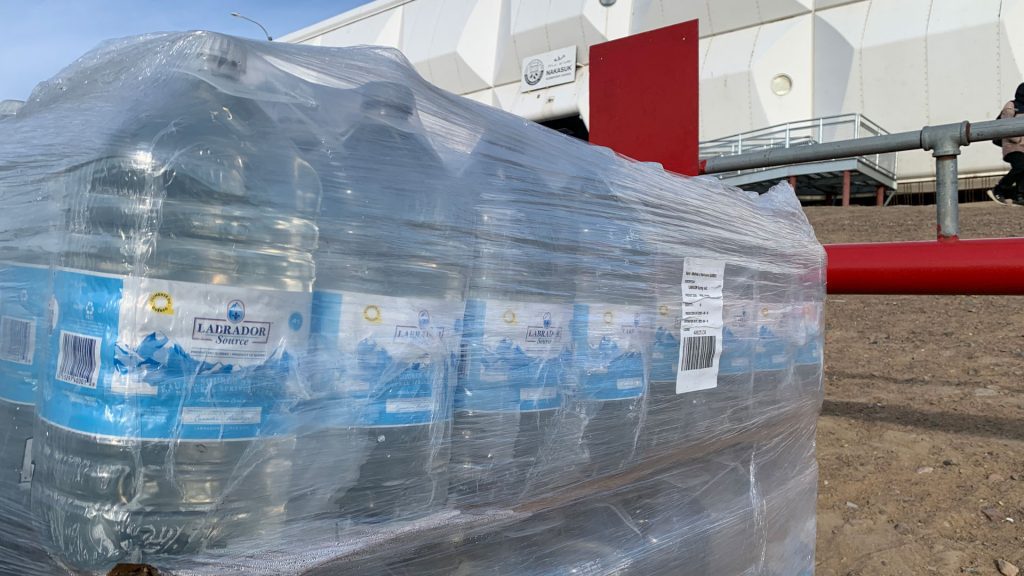
The Canadian Armed Forces are coming to help bring water to Iqaluitmiut while questions about the government’s response to Iqaluit’s water crisis are growing louder.
City and territorial officials made the announcement about the military during a news conference at Iqaluit City Hall late Friday evening.
Iqaluit residents have been unable to drink their tap water since Oct. 12, when petroleum hydrocarbons were discovered in the water. Since then, a mixture of river water and bottled water have been the city’s lifeline. Now, Canadian military technology used in disaster response could provide Iqaluitmiut with water.
Prime Minister Justin Trudeau, Public Safety Minister Bill Blair and Defense Minister Harjit Sajjan all took to Twitter Friday to confirm the news.
The technology is reverse osmosis, a water purification process that forces the undrinkable water through a membrane that catches contaminants. According to the military, that technology can provide up to 50,000 L of clean water daily. As of this weekend, the military was on-site in Iqaluit, trying to find a location to place the equipment.
“They’re looking at a few options,” explained Iqaluit Mayor Kenny Bell, “making sure that they fall under our emergency water licence.”
Nunavut’s Chief Public Health Officer Dr. Michael Patterson attended the city’s press conference, with a long PowerPoint presentation containing the actual test results from the water.
APTN News has been asking the government to provide those results for more than a week.
It confirmed that Iqaluit has been testing regularly for bacteria, turbidity, chlorine residue, general chemistry and metals. All of those tests continue to produce results within Canadian water standards. After petroleum odours were discovered in the water on Oct. 2, the health department began testing for petroleum hydrocarbons.
The first test they sent had no result, likely due to the wrong bottle being used to collect the sample. The second turned up positive for F2 petroleum hydrocarbons, diesel and kerosene. Further testing indicates that these contaminants were mostly found in a holding tank in the water processing plant, and were in smaller concentrations as they worked their way through the system.
In the holding tank, results for benzene, ethylbenzene, toluene, and xylene were between two and four times acceptable limits. According to the city’s chief administrative officer, those chemicals are lighter than water, and the way they float may have prevented further spread.
“They’re presenting as hydrophobic, and they tend to remain on the surface,” explained CAO Amy Elgersma. “That means they can be directly removed from those tanks using a vacuum system, preventing them from entering the City’s distribution system.”
The tank in question has been drained, bypassed, and is currently being investigated for cracks. While there are no visual cracks, engineers are searching for ones that may not be detectable by eyesight alone.
All evidence at this point is leading toward contaminants from nearby soil making their way into the water system. The water plant was first built in the 1960s, and so was the power plant directly next door. Iqaluit generates all their electricity from diesel, the power plant and the water plant have been next-door neighbours for more than 50 years. Diesel is what was found in the water.
“We do suspect that contamination from the soil, or groundwater, outside the plant has seeped into the water treatment plant and the affected tank. An environmental assessment, Phase 2, has begun,” explained Elgersma. Ground tests begin early next week.”
This is nothing new for Iqaluit, where there are contaminated sites all over the city.
“Iqaluit has a history of contaminated sites,” said Elgersma. “The previous airbase from the U.S. armed forces is well documented. It is well documented that there are contaminated sites around Iqaluit. As a part of the city’s environmental site assessment, we will be gathering the history of that site and surrounding areas.”
Iqaluit officials also announced they are putting in a full-time monitoring system to test for hydrocarbons and receive real-time results.
While the territorial government waited a week to release these test results, questions about what they knew, when, and who they decided to inform have been swirling in Iqaluit. A timeline is beginning to emerge.
Bell posted on Twitter in the morning of Oct. 12 that he had an emergency meeting with the Government of Nunavut about Iqaluit’s water problems. That afternoon, he told residents on Twitter –from inside that meeting- to not drink the water.
The Government of Nunavut Health department didn’t make the same statement until hours later. Government officials knew in the morning that the water was undrinkable, and if not for the mayor’s quick Twitter trigger finger, residents may not have known until evening.
“As the mayor has already put the Tweet out, the opportunity for us to add that, at that point, until we could get the announcement drafted, and get it interpreted into all four official languages, that is what was taking the time, to get that done,” explained Patterson.
That answer doesn’t account for the time between when the health department knew the water was poison and when they told the public.
They requested the emergency meeting the morning of Oct. 12, because they knew the water was toxic.
When asked why his department allowed residents to drink toxic water while they prepared a press release in four languages, Patterson said, “My recollection is there was work going on drafting that (emergency notice). When the emergency meeting happened, and the (Mayor’s) Tweet went out, the decision was made to work on the formal response that had more information, and was to be interpreted into all four official languages.”
While Bell’s Twitter account was used to sound the alarm for Iqaluit, it has also set off an acrimonious feud between the mayor and a local newspaper.
In an editorial titled “City took a gamble with Iqaluit’s water supply”, Nunatsiaq News took aim at the mayor for his response.
Odors began to appear in the water on Oct. 2, and some tests were completed, but not for hydrocarbons. The mayor told residents that the water was safe, based on the negative test results.
Nunatsiaq News Editor Randi Beers editorialized, “there’s no getting around the fact these same officials suspected something was wrong with the water and, without knowing how bad the problem was, chose to take a gamble over the health of almost 8,000 people living in Iqaluit.”
Bell vehemently disagrees with that editorial stance.
After being critical of Nunatsiaq News earlier in the week when the editorial was published, he used the news conference to double down on his opinion.
Bell was asked about his “spirited” response online.
He replied, “The reason I’ve been spirited, as you say, I would say even worse, towards Nunatsiaq News especially, is because it was wrong. Not only did we not gamble with the water safety, we’ve been working around the clock.
“The worst part of Nunatsiaq News is the comment section, as everybody in this town and territory knows, is a vile cesspit of nonsense… they’re allowing anonymous commenters to post complete garbage, especially towards city staff, who are literally working night and day to get this through.”









